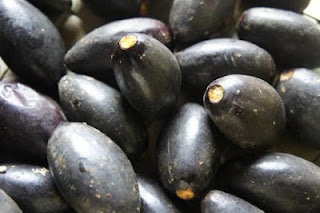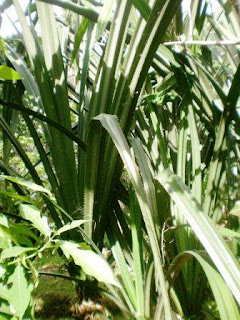Thursday, July 12, 2012
Wednesday, July 11, 2012
Native Tambis
With its crispness and slight tartness lacking the aftertaste of acridness, these native tambis are definitely not the same as the larger variety of their species.
The taste is sour but on the light side that only needs a pinch of salt to balance the sourness. This makes the fruits excellent for salads and garnishings.
In Bulusan, these fruits are seen around June and July strung neatly in fresh coconut midribs for sale in sari-sari stores and in front of houses with the fruiting tree. The trees are widely distributed and are still sighted in some backyards in the Poblacion.
Bulusan, Sorsogon, Philippines
Ripe Pili fruit is pure black
The first culinary lesson for a Bulusanon is how to prepare the pili fruit as 'ulam' or dish with the perfect pili pulp softness. I learned it this way: First is to master the right temperature of the water. Second is to know the right moment when it is done and to pick up the pili fruit selectively from the not so hot water (slightly higher than lukewarm). And never use boiling water--this has the opposite effect in most cases. The pili will turn up hard instead!
Best serve with 'kuyog', a local condiment made of fermented ziganid fry (baby ziganid fishes).
Tuesday, July 10, 2012
Kalo
Gathering data for the volume of karagumoy hats the locals refer simply as kalo revealed that these humble hats comprised actually a multi-million industry in town. The peak volume could reach around 2 million hats produced annually, the highest in the region and probably in the country.
It is obvious that the hats are intended as hats of utility and not for fashion which turned out to be as the reason for its longevity and constant demand especially from the agricultural regions outside Bulusan.
Pandanus simplex is karagumoy
From the Philippine Craftsman Reprint Series, 1913
The Pandan P. simplex, known as "karagumoy" or "carogumoy," is the economic pandan of the Bicol peninsula in southern Luzon.
Karagumoy leaves have a commercial value in many places in which the plant occurs.
In Bulusan* the production is large enough to supply the local demand and leave a surplus for export to neighboring towns.
*misspelled as Balusa in the document
Karagumoy Weaving Today
The tools of the trade are still the same-- from the 'hurmahan' (wooden block mold), hiyod (bamboo stick for softening the strips of karagumoy) and stone polisher. Also, the weaving process remained practically the same almost a century after it was documented by the Philippine Craftsman of 1913.
Only the presence of a cellphone and the attire of the young hat weaver tell us that it is so 2011.
Subscribe to:
Posts (Atom)
















































